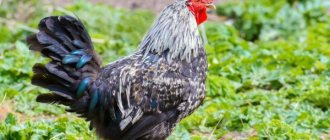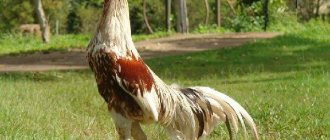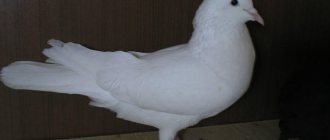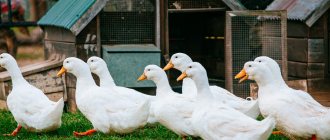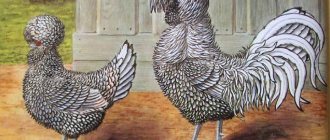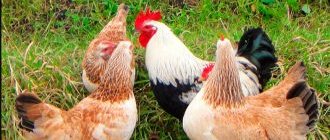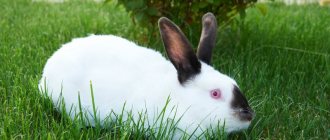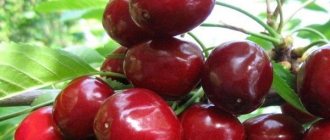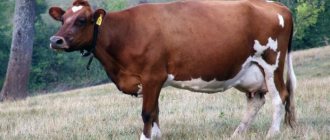Cameroon goats are known all over the world; they are as popular as dwarf ponies, pigs and other small copies of animals. Goats are bred to produce milk and meat; caring for the Cameroon breed is not difficult, but it requires a lot of time.
Cameroon goat
Cameroon goats do not need much feed
Cameroon goats have strong immunity
History of the origin of Cameroonian goats
The Cameroon goat is considered one of the first domesticated breeds. Even 10 thousand years ago, the inhabitants of the Middle East were able to domesticate these animals. Huge interest in miniature goats arose during the mass killing of whales.
Cameroonians can easily tolerate long periods of time on a ship, and they also do not need a lot of food. Whalers often used them to obtain milk from goats, and later meat.
Goats arrived in Europe in the 19th century, and in North America in the mid-20th century. Animals are bred in tropical conditions. The miniature goat is considered one of the most popular pets of tropical forest farmers.
Today, the prevalence of such goats is from Sudan to Zaire. In the Southern Continent, farmers create small goat ranches because the profitability of small animals is much higher than other large animals.
In the Middle East they are also popular with tigers. This is very surprising, but predators do not eat goats, they drink their milk and release them.
As for the territory of the Russian Federation, miniature goats appeared only at the end of the 20th century and spread to the Novosibirsk, Moscow and Kaliningrad regions.
Animal diet
The menu of this breed should be balanced and varied . Be sure to include products such as:
- fresh grass in summer and hay in winter;
- vegetables: cabbage, carrots, beets;
- grain crops;
- apples;
- boiled potatoes mixed with feed;
- fresh Jerusalem artichoke;
- corn;
- chopped oats.
For good digestion, it is necessary to give animals at least a small handful of whole grains daily.
Provide animals with constant access to water. In the summer, drinking bowls with fresh and clean water must be installed on the pasture. And in winter, the water in the drinking bowls should also be warm.
Do not overfeed Cameroonian cats, as they love to eat, but this does not have the best effect on their health. Overeating leads to poor health, lethargy, passivity, and problems with bearing offspring. As mentioned earlier, their diet should contain less protein food, since it negatively affects the health of such goats.
Description of the breed
The main feature of Cameroonian goats is their miniature appearance, which is why they are called dwarf, pygmy or mini goats. The animal reaches a height of 0.5 m and a length of 0.7 m. The weight of a male varies from 16 to 24 kg, and that of a female from 9 to 16 kg.
Appearance and color
The main characteristic features of Cameroon goats:
- the body is barrel-shaped, low-slung and small;
- miniature head, compact;
- not long, but strong legs;
- small beard;
- small backward curved horns;
- upturned tail.
The colors of Cameroonian goats are varied, they cover a wide palette of shades: from black to light color. Markings and stripes are allowed on the color. The coat has a dense undercoat. This structure allows Cameroonian goats to withstand the cold climate of our country.
Character
As for behavior, dwarf goats are not particularly different from their counterparts. They are very active and stubborn. If a Cameroonian individual decides that she needs to “go there”, then she will get “there” by any available or inaccessible means. She will wait for the moment when she can seep into the desired place.
Some reviews of Cameroonians note their evil character. But in fact this is not the case; anger is not inherent in these animals. The fight with the owner does not occur from anger of temperament, it is due to the fact that the animal seeks to occupy its niche in the hierarchy of the herd.
Excellent appearance and small size prevent the owner from noticing in time the moment when the male begins to go beyond what is permitted. As a result, the goat thinks that he is in charge and tries to put the owner “in his place.”
In order to remove the animal from the position of leader, the owner of Cameroonian goats will have to struggle with it for a long time and painfully, which is why it seems that they have an evil disposition. It is better to notice this zeal for “power” in animals at the beginning, then it will be possible to get by with fewer conflicts with the Cameroonians.
Females are very attached to their owner, they love kindness and affection. They get used to the owner too quickly and easily and do not like to be left alone. The only main thing is that the owner does not offend them.
In case of bad behavior, goats can be calmed by spraying them with a spray bottle.
Productive characteristics
Despite their miniature size, Cameroon goats are very productive. Even 1-2 individuals can provide the entire family with dairy products. As for costs, the Cameroonian individual is much more profitable than its ordinary counterparts.
The average milk productivity is 2-2.5 liters per day. The product is fatty and tasty, sometimes the fat content reaches 6%. With high-quality animal care, it does not have a specific odor.
The amount of iron, potassium and phosphorus in milk is many times greater than that of ordinary goats. Anyone who decided to have a Cameroonian for meat will also be happy, because this product is considered dietary and tastes like rabbit meat.
The lifespan of Cameroonian goats is about 20 years.
Choice
To obtain milk, it is better to choose a goat that has had at least one lamb. In such an animal, the nipples are already developed enough to create a minimum of inconvenience during milking.
On a note! Cameroonians also differ from Pygmy ones in the size of their nipples.
Pygmies have very small nipples and are poorly suited for milking. Cameroonians have much larger nipples and udders.
The methods for choosing the right Cameroon goat are the same as when choosing large dairy breeds:
- correct exterior;
- udder without defects and regular shape;
- checking milk yield before purchasing;
- no extra nipples.
For Cameroonians, having only two main nipples is a very important factor. For a large goat, this issue can be neglected, but since you literally have to milk a Cameroon goat with three fingers, the extra teats will be a big nuisance.
Young Cameroonians are milked using the thumb, index and middle fingers. After the second lambing, queens can be milked with a “fist”, but in this case the index finger is excluded from the process.
The video shows that Cameroonian has quite large nipples. But the “tame since childhood” thing is a marketing ploy.
Important! It is better not to eat the milk for the first 2 weeks, giving it to the kid.
If the kid is left under the uterus, the remains will have to be milked at first. During the first 2 weeks, the uterus produces colostrum, even when it is no longer distinguishable from milk in color. But the taste is no good. After 2 weeks the milk becomes sweet.
Advantages and disadvantages
Despite their amazing appearance and excellent productive qualities, Cameroonians have both pros and cons, and they should be taken into account when breeding these animals.
Advantages of the Cameroon breed:
- small size;
- undemanding in nutrition and care;
- resistance to climate change and different temperatures;
- low cost of keeping goats;
- good fertility;
- strong immunity;
- amenable to training and education;
- good disposition, with proper upbringing;
- Thanks to their curved horns and friendliness, goats do not harm children.
Disadvantages of the breed:
- get sick in damp and humid climatic conditions;
- are too stubborn and butt heads when stressed or scared;
- they do not like loneliness; if left alone for a long time, the animal begins to get angry with the owner, and its behavior changes.
What are the requirements for care and maintenance?
The Cameroon goat is one of the most unpretentious pets. It is perfect even for indoor living, is easily trained to walk on a leash and is easy to train.
Cameroon goats can even be kept in an apartment.
In farm conditions, you will need to prepare a dry, bright, spacious and warm room for goats. In winter, the temperature in it should not be lower than +17+18C. A large enclosure for walking is also required, with a total area of about 8 square meters. m. per individual.
In order for animals to feel good and not get sick, they need to be dewormed regularly (at least 3 times a year). Animals will have to have their hooves trimmed once a month. It is advisable to do this in damp weather so that the hooves soften slightly. The day before the procedure, they are thoroughly coated with red clay, and immediately after trimming, they are treated with vinegar (9%).
Attention. When raising dwarf goats, it is important to ensure low humidity and absolute cleanliness in the barn. Grain straw is used as bedding.
In their natural habitat, Cameroonian goats are good at climbing trees and rocks. Therefore, it is advisable to leave a couple of small trees in the paddock and make several high hills and slides. Their maintenance does not require any additional costs. However, if you live in a swampy or subpolar area, then you will have to choose a different breed for breeding.
Content Features
Miniature goats of this breed perfectly adapt to various living conditions; they can easily tolerate heat and sub-zero temperatures. They can stay outdoors for a long time, the only thing that negatively affects them is drafts and dampness.
Premises requirements
A goat shed should be bright, clean and spacious. It is better to line the walls with mineral wool to keep it warm in winter. Heating devices are not installed in such sheds; often individuals manage to heat themselves.
Make separate stalls in the room with beds for each goat, the area of one being at least 0.8-1.3 square meters. m. Despite their miniature size, individuals still need a large walking area - about 6 square meters for 1 goat. m.
Caring for young animals: maintenance and feeding
After the birth of a new offspring, it is immediately taken from the mother and fed with colostrum. At 1 month after birth, goat kids are fed as follows:
- Meal schedule: 4-5 times a day, from 6.00 to 21.00.
- At the age of 10 days, babies are given hay in small quantities; it must be of high quality.
- Add 5 g of table salt to food daily to prevent babies from developing white muscle disease.
- At 3 weeks of age, add grain mixtures to the food. The best options are cake, bran and oats. Mix them with 10 g of chalk.
- At the age of 3 weeks, offer babies fresh boiled oatmeal and finely chopped root vegetables.
Kids and adults of this breed do not have enough food, so the farmer must constantly monitor the amount of food. If the goats are obese, they will not want to mate, and the females will begin to give birth to weak offspring.
Feeding
All reviews from farmers claim that individuals of this breed are not picky eaters. Simple goats can snort with displeasure at the sight of food, but these small animals even make do with pasture food. Goats are excellent at climbing trees and other hills, so they also find food on the tops of small trees.
To provide for Cameroonian goats, food is needed 5-7 times less than for its ordinary counterparts. Animals eat: cabbage, hay, greens.
Feeding standards
The milk of Cameroonian goats has a high fat content, so it is necessary to monitor the feed to ensure that the product is nutritious. One of the main components of an animal's diet is protein.
To improve the functioning of housing and communal services, you should adhere to a certain scheme: roughage - 20-40%, concentrated feed - 40-50%, the rest is greens. It is better to give protein in granular mixtures.
Let's consider the nutritional norm for a male weighing 25 kg: fresh grass (3 kg), dried grass (0.5 kg), concentrates (0.25 kg). Cameroonians can make do with the grass growing under their feet.
Running a goat
Launching a goat is a preparatory stage for a female to give birth; she is fed with special foods so that she can bear and give birth to healthy offspring. This process begins approximately 1.5 months before goatling.
First of all, add protein to your diet. The feeding scheme is as follows: foot feed in any quantity, sainfoin grass (0.5 kg), oatmeal mixture (0.5 kg), concentrates (0.2 kg).
The second option for the nutrition plan: pasture feed in any quantity, alfalfa hay (0.5 kg), oats + peas (0.5 kg), concentrates (0.1 kg).
It is important to combine feeding with watering: give juicy foods before drinking, concentrated foods after. Cameroonians are characterized by an active metabolism, so they need maintenance feeds much more than ordinary goats.
Walking in the pasture
On pastures, animals eat a huge amount of grass: goats 2.3-2.6 kg, goats - 2.6-3 kg, kids - 0.6-1 kg. With inadequate nutrition, animals begin to become active and mischievous; they eat inappropriate “products”, such as bags or films. Cameroonian individuals are excellent at absorbing fiber.
What and how often do goats get sick?
Among all goat breeds, Cameroonians have strong immunity. Individuals quickly get used to different climatic conditions, but there is one thing they cannot tolerate – high humidity and sub-zero temperatures. Drafts are not goats’ best friends, so close all cracks in the room and prevent even the slightest breeze from appearing. Better install ventilation.
Cameroonian goats are not afraid of infectious diseases. They do not suffer from brucellosis, hoof infections, pseudotuberculosis, and are also not afraid of various blood-sucking insects. In addition, Cameroonian goats got along well with Tsetse flies in their homeland.
The only drawback regarding health is regular allergies to some plants, so when changing herbal-based feeds, monitor the animal’s reaction.
History and characteristics
A completely different type of miniature animals, the keeping of which has recently become fashionable, are dwarf goats. In some African countries, these small goats are common animals domesticated and used by humans for meat and milk for many centuries.
Since the first representatives were brought from Cameroon, the common name for these little ones is Cameroon goats. Typically, the weight of the animal does not exceed 25 kg, and the height at the withers is 50 cm (for comparison: the German Shepherd dog breed standard provides for a weight of up to 40 kg with a height at the withers of up to 65 cm).
In their homeland, Cameroonian goats are not a subject of admiration, much less keeping as pets - they are ordinary farm animals, freely roaming the streets of villages in search of greenery. Their miniature stature and agility allow goats to jump onto the lower branches of trees and feast on foliage that is inaccessible to other animals.
The maintenance of these crumbs is economically justified - with a feed consumption of approximately 3 times less than that of an ordinary goat, they are capable of producing up to one and a half liters of milk per day, and at the peak of lactation, with good feeding, up to 2.5 liters. Lactation itself continues for 6-7 months from the moment the babies are born.
The gestation period for mini goats is absolutely identical to that for regular goats and is about 5 months. As a rule, kids are born in pairs. The baby goat's weight at birth is only 350-400 g, but within a couple of hours after birth the baby is already standing firmly on its legs and running after its mother.
It is clear that, given the presence in our country of dairy goats of various breeds capable of pleasing the owner with an annual milk yield of up to 1000-1200 liters of milk, keeping mini-goats for the sake of production seems at least controversial. But these animals have taken root as pets.
Possessing a sensitive and good-natured disposition, mini-goats are very responsive to affection. At the moment, they can be found in almost any zoo - they approach visitors, look trustingly into their eyes, and beg for a treat.
The animal's miniature size and backward-curved horns, which are practically incapable of causing injury, make dwarf goats a fun living toy, perfect for communicating even with small children.
Breeding the Cameroon breed
Puberty in goats occurs at the age of 7 months, so at this age it can already happen to produce offspring. Goats carry their offspring for about 5 months and produce 1-2 kids per lamb. But the surprising thing is that in 1 season they can produce offspring 2 times.
Features and types of Cameroonian insemination
Experienced farmers do not advise breeding individuals too early; it is better to wait until the animals are 1 year old. Childbirth at an early age negatively affects the development of the female, so avoid unforeseen situations.
Mating options:
- Artificial insemination. All questions and processes for fertilizing a female are left to the veterinarian. He will correctly carry out the insemination procedure and preserve all breed characteristics. Moreover, this action can be performed several times.
- Manual mating. The owner of the Cameroonian independently selects the individuals who will have to mate. To do this, prepare a small pen where the goat will not have to “groom” and “catch up” with the goat for a long time.
- Free insemination. Animals themselves decide who and with whom to mate. In this case, the main thing is that all individuals are of the same breed, otherwise unnecessary mixing of different bloods will occur.
The best option for Cameroon goats is hand mating. In this case, the owner himself will regulate the time of birth of the babies, their number, etc.
It is better for kids to be born in the spring. It is necessary to carefully select the “parents” and monitor their nutrition and health.
Gestation period and lambing characteristics
Officially, the pregnancy period for Cameroonian women is 5 months, but in fact this is not the case. Often, individuals give birth on day 140-150. You need to prepare for this process in advance: heat the water, take scissors, rags. But more often, goats cope without the help of their owner. Dwarf animals give birth without any particular difficulties: first, the first kid appears with its legs forward, the rest in the reverse order.
The offspring stand on their feet as soon as they are completely dry, after 4 hours they confidently run around the paddock. 2 hours after birth, kids should be fed their mother's colostrum to protect them from infections.
Feeding schedule: every 4 hours. Having salt in your food will help prevent white muscle disease. From the 3rd week, add root vegetables and fruits to your food, just do not forget to chop all the food.
Breeding, maintenance and nutrition
The mini-goat is not capricious to living conditions. You can even keep her in a chicken coop; she will also make friends with neighboring birds. Goats will enjoy artificial slides and indoor mounds - they have excellent climbing abilities. Main comfort conditions:
- dry room with straw bedding;
- temperature not lower than 17 degrees;
- constant availability of water;
Attention! It is recommended to cool the water in goat drinking bowls in summer and heat it up in winter.
- spacious enclosure for walking.
An important maintenance requirement is that the hooves must be trimmed monthly. After pruning, be sure to treat with disinfectants - table vinegar or copper sulfate. Despite their exotic origin, goats do not require special feed. Although to obtain high-quality milk, you do not need to neglect a balanced diet. Everything should be in moderation - grains, herbs, apples and vegetables. Ready-made goat food in granules is also suitable. And free-range goats will be happy to get themselves fresh leaves and branches.
Cameroonians are very active animals. If they are kept in an apartment, they can cause significant damage by jumping on windows and cabinets. Therefore, even taking into account their charming, affectionate disposition, it is more comfortable to keep them at home.
Breeding goats does not cause much trouble, to the point that females do not need to be given a separate room for lambing. They reproduce safely, without the help of people, giving 1-2 kids per lamb. True, it is recommended to keep and feed newborn goats separately from their mother. For feeding, colostrum is used - the milk of a lactating goat, which is unsuitable for about a month for the owners' menu.
The African dwarf goat is an ideal milk nurse. Thanks to her affectionate, cheerful disposition and affection for her owners, the animal is very popular among farmer breeders. And in addition to tangible profits, it brings a lot of positive emotions to children and adults.
Breed value
Today, cheese making is one of the leading areas in food preparation. Despite the high fat content of milk, it does not have a specific odor, so the product can be used to make cheese. Milk stays in good condition in the refrigerator for a couple of weeks.
In addition to good fat content, the product contains a huge amount of useful microelements such as calcium, potassium and phosphorus.
Animal meat has excellent taste and quality, has no aftertaste, contains a small amount of fat, and is therefore considered dietary. But Cameroonian women are very rarely bred just for meat.
The cost of Cameroonian is high, for example, an individual at the age of 4 months costs about 9,500 rubles, a pregnant goat costs 12,000 rubles. And these are still the lowest prices. Considering the high profitability of breeding and the minimal costs of keeping goats, we can conclude that individuals are beneficial for breeding not only for themselves, but also for commercial purposes.
Caring for young animals
Experienced farmers recommend weaning young goats from their mother almost immediately after birth. Then they will have to be fed with warm colostrum on their own.
Kids are switched to an adult diet from the age of two months.
At the age of 1 week, babies can be given fresh, high-quality hay and 4-5 grams of salt per day, and after another week, regular milk is introduced into the diet. They need to be fed at least 4 times a day. The first feeding is usually at 6 a.m. and the last at 9 p.m. When kids turn 1.5 months old, they no longer need milk.
Reviews
★★★★★
Oksana, 53 years old, obstetrician. Pskov. One day I accidentally went to an agricultural exhibition and really liked these miniature goats.
I have never regretted buying them; now they serve as real guards of my territory. The animals very quickly got used to me and all family members, but they don’t like strangers, they can rush at my feet and start butting. The cheese made from their fatty but tasty milk turns out excellent. ★★★★★
Ivan, 38 years old, journalist, Krasnodar. I started breeding dwarf goats 5 years ago.
It all started with 2 females and 1 male. Now I have a herd of 25 heads. They don't bring much milk, but it is very rich and tasty. I make goat cheese from it; restaurants in the city readily buy it. Hide
Add your review
Interesting facts about Cameroon goats can be found in the following video:
Cameroon goats are popular among farmers due to their charming appearance, friendly disposition, strong immunity and excellent productivity. Breeding and keeping these goats is not only very profitable, but also charges the owner and the whole family with positive energy every day.
0
0
Copy link
